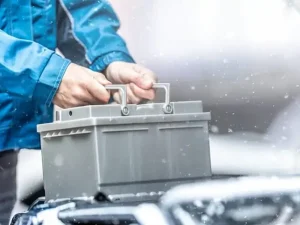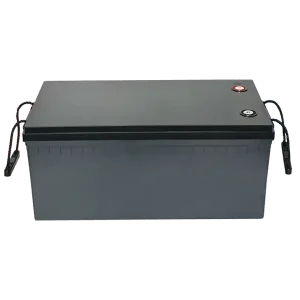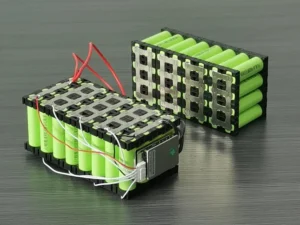As winter arrives, many of us face problems with our devices that run on batteries, Right? You might wonder: What is the common reason behind that? Actually, batteries don’t work as well in the cold. As a result, your car engines slow down, phone batteries die faster, and power tools do not work well. But why is that and what’s the best battery for cold weather?
This question often comes to mind when facing those problems. However, the good news is that not all batteries give up when it gets cold. Some can efficiently handle low temperatures, even freezing conditions. Knowing that type of battery can save you time, money, and effort. Therefore, I will discuss batteries that can survive cold. So, let’s get started!

Why Cold Weather Affects Batteries
We all know that cold affects battery performance. But have you ever wondered why? Before we explore the best cold-weather battery, let’s explore those reasons.
- Slower Chemical Reactions: Inside a battery, there are special chemicals. Those chemicals react with each other to generate the electricity to power your device. However, in the cold, the chemical reaction slows down. As a result, the battery cannot produce enough energy to power the divide.
- Increase Resistance: As I said above, electricity inside the battery powers your device. But the battery’s inside becomes thicker in the cold, increasing resistance. As a result, electric current cannot flow smoothly. The slow moment of current affects the battery performance.
- Lower Voltage Output: Voltage is the push that moves electricity from the battery to divide. Due to a slow chemical reaction, the battery cannot produce enough voltage in the cold. As a result, your device may not turn on at all or take time.
- Reduced Capacity: Capacity refers to how much energy your battery can hold and use. In the cold, the batteries’ capacity reduces. The reason is that the battery cannot use its stored energy due to a slow chemical reaction. As a result, even if your battery is full, it might act like it’s half-filled.
- Long Charge Time: You might notice that your battery takes more time to charge in the cold. Tiny particles move during charging and store energy. But in the cold, the inside of the battery becomes thick, so their movement also slows down. As a result, it takes a lot of time to charge the battery fully.
What’s the Best Battery for Cold Weather?
As I said above, not all batteries perform equally in cold conditions. Some lose their power quickly and take more time to charge. That’s why choosing the correct battery is crucial to outdoor gadgets such as cars and RVs. Remember, the best batteries for cold conditions deliver enough power to operate a device. Hence:
Lithium batteries are one of the best batteries for cold weather. These are rechargeable batteries that you can find everywhere. A lithium battery stores energy and gives it out when needed. However, unlike regular batteries, they do not use gas or liquid. Instead, these batteries use lithium ions that move and produce electricity.

But the question arises: How do these batteries work? Actually, they have three main parts. The first is an anode, which is negatively charged and mainly made of graphite and carbon. The second is the cathode, which is positive and made of lithium. The last one is an electrolyte, a special liquid that helps the lithium particles move.
So, when you charge the battery, lithium particles move from the cathode to the anode. These particles stay there and start strong. However, when you use this battery, these particles shift from anode to cathode. This movement produces electricity that powers your device to run. What makes these batteries stand out is their ability to withstand fluctuating conditions.
Lithium batteries are equipped with Battery Management Systems (BMS). This electronic part protects the battery from overheating and ensures charging in cold weather. These batteries come in various types, such as lithium-ion batteries and lithium iron phosphate (LiFePO₄). Each type has different specifications and lifespans.
Why are Lithium Batteries the Best for Cold Weather?
We have concluded that lithium batteries are the best choice for cold weather. But what truly makes them best fit for freezing conditions? Let’s find out the reasons in this section.
1- Durable Materials
One of the biggest reasons lithium batteries are great for colds is their material. They are made with a special, long-lasting material. Generally, regular batteries shrink or crack in cold conditions. As a result, internal liquid leaks, damaging the battery structure and affecting its lifespan.
However, lithium batteries have a solid design. For example, their inside parts are neatly packed and properly sealed. This extra sealing protects the body from moisture, snow, and ice. As a result, they do not rust quickly and do not wear in the cold. No wear and tear means a leakage-proof battery with an enhanced life span.
2- Better Electrolyte
The electrolyte is the most critical part of a battery. It ensures the smooth movement of ions inside and helps in generating electricity. However, in cold conditions, this electrolyte becomes thick. As a result, the movement of ions becomes slow, and electricity is not generated. This can cause the engine to cease or any other powering tool to stop.

However, a lithium battery, especially a lithium-ion battery, contains a special organic electrolyte. It is mainly made of ethylene carbonate or lithium salt. This electrolyte does not freeze even in freezing conditions. This allows ions to move smoothly and fluently from cathode to anode or anode to cathode. Therefore, lithium batteries work better in cold weather.
3- Faster Ion Movement
As I said above, tiny particles move and generate electricity inside a battery. The fast speed of these ions means speedier power delivery. However, their speed mainly depends on the electrolyte. In cold conditions, electrolytes become thick, and ions’ movement slows. As a result, power is not delivered faster, which can cause the device to cease.
However, lithium batteries contain a special organic liquid. It does not become thicker in the cold and continuously allows smooth and fast ion movement. Moreover, these batteries have a tight internal structure. This means that ions need to travel a shorter distance from one electrode to another. This short distance further increases the speed and efficiency of ions.
4- Lower Internal Resistance
Resistance is an invisible blockage that hinders the electricity flow. Each battery has some internal resistance. The higher the resistance, the more energy is wasted. In normal batteries, this resistance goes up in the winter. As a result, ions cannot move freely. This disturbs the electricity flow and stops the power delivery to the device.
However, lithium battery manufacturers design them with low internal resistance. For example, their electrodes are made with conductive material. Moreover, the electrolyte is carefully chosen to remain thin in the cold. All these factors automatically decrease the internal resistance, which regulates smooth ion flow.
5- Higher Energy Density
Energy density indicates how much energy a battery can store. A battery with a higher energy density means it can store more energy, which you can use later. As you know, in winter, every bit of power matters. If a battery cannot store enough energy, it cannot start the device.
However, lithium batteries, mainly lithium polymer batteries, can pack more energy. WHY? First, they have lithium-based compounds that can store energy efficiently. Moreover, their compact design allows fast movement of ions. This means that even in cold weather, they can supply enough power to initiate your device.
6- Built-In Heaters
It is one of the coolest features of lithium batteries, making them suitable for cold weather. As I said above, chemical reactions require some heat to occur. Those reactions do not happen in cold weather, and the battery cannot perform well. However, lithium batteries come with built-in heaters.
When the battery detects low temperature, it turns on these heaters. They start warming the battery and initiating chemical reactions. As a result, the battery delivers strong power, charges properly, and prevents damage from a cold. That’s why lithium batteries, such as lithium iron phosphate batteries, are the best choice for cold weather.
Tips to Protect Your Battery in Winter
Cold weather can be harsh on batteries. It can slow down or even stop them from working, whether in your car, RV, or solar system. Are you facing the same problem? Worry not! Here are some tips to keep your battery durable and healthy even in freezing temperatures.
- Keep It Warm: As you know, cold can slow down the movement of ions. One of the best things you can do is to keep your battery warm. For example, keep it in outdoor places such as a heated garage. Moreover, you can also use battery blankets and covers to provide enough heat.
- Charge it Regularly: Cold weather significantly affects battery capacity and lowers it. Therefore, you should not leave your battery empty. Charge it regularly. Moreover, make sure it is fully charged before storing it.
- Keep Terminals Clean: In cold weather, moisture builds up on the terminals. This can cause corrosion and block the flow of electricity. Therefore, regularly clean the terminals with a dry cloth. It is better to apply terminal grease or petroleum jelly to avoid corrosion.
- Store it the Right Way: If you are not using the battery in winter, store it properly. For example, do not leave it empty; charge it up to 50% before storing it. Moreover, store your battery in a dry but not freezing place.
- Avoid Charging in Freezing Temperatures: Charging batteries below 0°C can be harmful. It can permanently damage the battery and even burst. So, before charging in the cold, warm it up first. After that, let it come to room temperature and plug it in.
Conclusion
You often notice that batteries do not work well in the cold. The main reason for this is that the inner electrolyte becomes thick. As a result, ions cannot move and cannot generate enough electricity to power your device. In this condition, those batteries with low internal resistance and high energy capacity survive.
Thus, lithium batteries come into the scene and handle those harsh conditions. These batteries have built-in heaters. These heaters provide enough heat to initiate the chemical reaction and generate power. Moreover, organic electrolytes and better energy density make them stand out in winter. So, I highly recommend these batteries for better performance, even in the cold.
